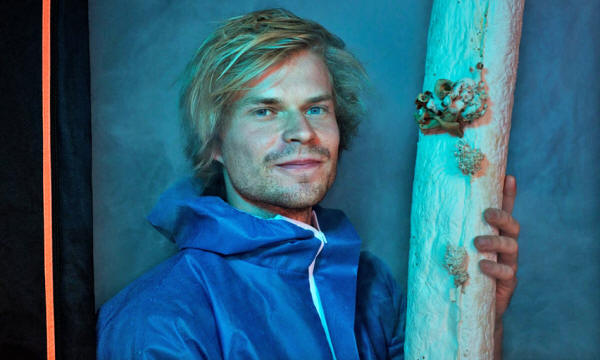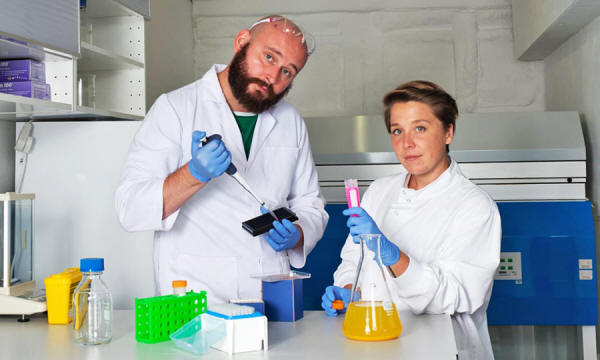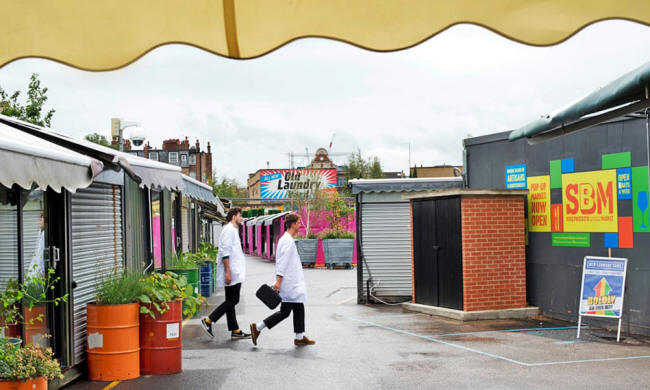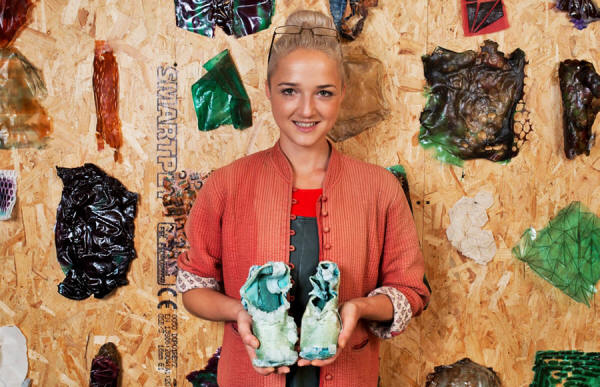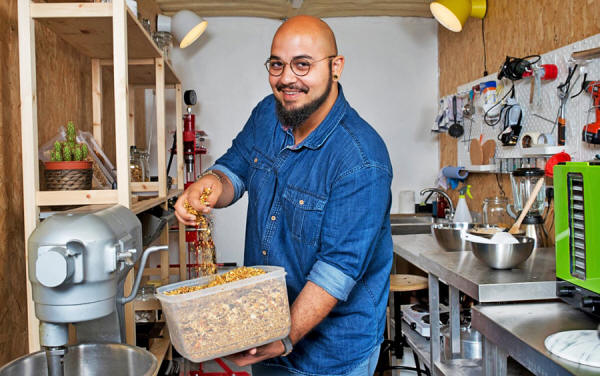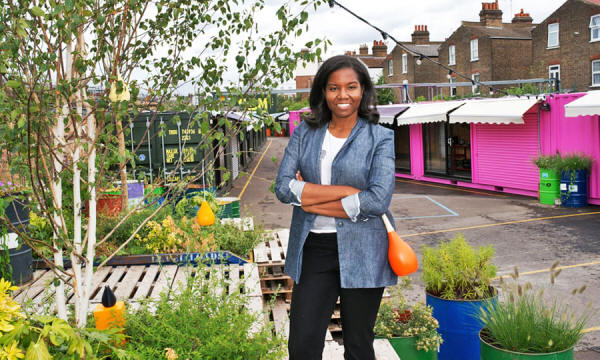|
a startup developing sustainable building methods, including a bio material made from fungi.
Photograph: Sophia Evans for the Observer in a Shepherd's Bush market is the unlikely home to a community of startup research projects.
This is the unassuming entrance to the Open Cell "bio-village", a collection of 45 shipping containers being converted into pop-up biotechnology labs and workspaces.
One of the giant green containers already houses a surprisingly light and airy molecular biology lab, furnished with donated professional equipment.
A small community of
startups and entrepreneurs are busy converting other containers into
more labs, offices and workshops and will use this low-cost,
unconventional space to share equipment and ideas.
There is a startup that "grows" buildings out of fungi, while another helps farmers pollinate crops using swarms of flies controlled with an app.
Thomas Meany and Helene Steiner at work; their company Cell-Free Technology tests biological circuits.
Photograph: Sophia Evans for the Observer
The shipping containers were originally placed here as part of Hammersmith and Fulham council's efforts to regenerate the market area, which has been here since 1914 and was saved from being turned into flats in 2016.
After a range of other
pop-up businesses didn't take off, the council and developers
decided to try something different.
helps break down the barriers
between people
working in different fields...
As the commonest techniques in molecular biology have become cheaper and more easily automated, once distant fields such as biology, design, art and engineering are blurring together in unusual and creative collaborations.
These groups need low-cost facilities to develop creative ideas into businesses.
The site's aesthetic - shipping containers, street art, cool young people making things and smoking roll-ups - may superficially suggest just another faddy regeneration project.
But the Open Cell bio-village is backed by high-profile scientists from nearby Imperial College London, who, despite the modest sign at the front, are very excited indeed about what is going on in the containers.
Rowan Minkley and Rob Nicoll of Chip[s] Board. Photograph: Sophia Evans for the Observer
In the market, famous for its fresh food and fabric, the stallholders seem unconcerned by the science and technology hub developing beside them.
Some took issue with the idea of pop-up bars serving alcohol here in the middle of the afternoon, but none seems to have even noticed their new lab coat and safety goggle-clad neighbors.
Safety is the obvious issue when placing a biotech laboratory in a crowded public space.
The site is currently a Biosafety Level 1 facility, the lowest of four health and safety categories (Level 4 being labs that work with fatal airborne diseases).
While the project finds its feet, the founders have deliberately stayed away from any tenants wishing to do anything "controversial", such as biomedical research that would involve human tissue or pathogens.
With more tenants moving into containers every week, there are plans to connect several of the containers to create an even more hi-tech "community lab" and make the entire site open for the public to learn about what modern biology can do.
The curious juxtaposition of this corner of west London, where traditional fabric sellers and biomaterial scientists coexist in the same space, is perhaps the most interesting of all the experiments going on here.
But even the founders don't have a solid idea of what direction the site may take.
holds a pair of ballet shoes adorned with sweat crystals. Photograph: Sophia Evans for the Observer
She is hoping to create sustainable bioplastics and fibres made from algae and other sustainable materials, including food waste. In her more experimental work, she creates garments covered in crystals that have been grown from an individual's sweat and other bodily fluids.
Her favored raw material, she says,
She now has more than 400 samples of different materials as part of her experiments to find potential uses in the fashion industry.
She recently moved out of her university studio after finishing her master's and, before moving to the shipping containers, had been using her kitchen at home for her work.
His company Biohm develops construction materials from sustainable sources. Photograph: Sophia Evans for the Observer
One of the company's most exciting new biomaterials is made of mycelium, the fine filaments of fungi that normally grow underground. The mycelium are harvested, fed on agricultural or food waste and grown in large sheets or blocks.
Once the living element is killed, a fire-resistant structural material with excellent insulating properties is left.
Biohm has transformed its shipping containers into a fully functioning "materials research lab".
It's part kitchen - full of blenders, pots, pans and batches of what looks like muesli - part DIY (do it yourself) microbiology lab, with fungi samples growing in an eerie, steaming, zip-up cupboard.
Sayed and the Biohm team are also working on a radical new method of building that has no permanent fastenings and can be taken down and rebuilt at any time.
Tashia Tucker's startup Olombria uses pheromones to get hoverflies to act as pollinators.
Photograph: Sophia Evans for the Observer
The technology involves releasing hoverflies and controlling their movements using pheromones, emitted from devices hung around the crops.
The release of the pheromones is controlled by the farmer using an app and the flies' behavior on the crops is tracked using hi-tech cameras.
Flies are thought to account for around 30% of all pollination, are easier to grow and manage than bees and are "less picky" about going out in wet or cold conditions.
Tucker and her colleagues came up with the idea last year after being encouraged to enter the Royal College of Art's Biodesign Challenge, a competition that brings together artists and scientists.
The team won and now have offices in Battersea, south London, and here at Open Cell.
|


